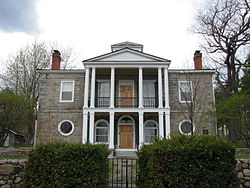
The Winslow House is a Frank Lloyd Wright-designed house located at 515 Auvergne Place in River Forest, Illinois. A landmark building in Wright's career, the Winslow House, built in 1893–94, was his first major commission as an independent architect. While the design owes a tremendous debt to the earlier James Charnley House, Wright always considered the Winslow House extremely important to his career. Looking back on it in 1936, he described it as "the first 'prairie house'."

Arrowhead, also known as the Herman Melville House, is a historic house museum in Pittsfield, Massachusetts. It was the home of American author Herman Melville during his most productive years, 1850–1863. Here, Melville wrote some of his major work: the novels Moby-Dick, Pierre, The Confidence-Man, and Israel Potter; The Piazza Tales ; and magazine stories such as "I and My Chimney".

Sunnyside (1835) is a historic house on 10 acres along the Hudson River, in Tarrytown, New York. It was the home of the American author Washington Irving, best known for his short stories, such as "Rip Van Winkle" (1819) and "The Legend of Sleepy Hollow" (1820).
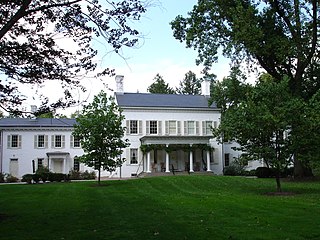
Morven, known officially as Morven Museum & Garden, is a historic 18th-century house at 55 Stockton Street in Princeton, Mercer County, New Jersey, United States. It served as the governor's mansion for nearly four decades in the twentieth century, and has been designated a National Historic Landmark. It is listed on the National Register of Historic Places.

The Franklin Pierce Homestead is a historic house museum and state park located in Hillsborough, New Hampshire. It was the childhood home of the fourteenth President of the United States, Franklin Pierce.

The Emil Bach House is a Prairie style house in the Rogers Park neighborhood of Chicago, Illinois, United States that was designed by architect Frank Lloyd Wright. The house was built in 1915 for an admirer of Wright's work, Emil Bach, the co-owner of the Bach Brick Company. The house is representative of Wright's late Prairie style and is an expression of his creativity from a period just before his work shifted stylistic focus. The Bach House was declared a Chicago Landmark on September 28, 1977, and was added to the U.S. National Register of Historic Places on January 23, 1979.

The Charles A. Miller House is a historic residence in Cincinnati, Ohio, United States. Built in 1890 according to a design by Samuel Hannaford, it is a two-and-a-half story building constructed in the Gothic Revival style. A brick and limestone structure with a slate roof, its facade is dominated by courses of ashlar, plus battlements at the top, and a prominent portico at the entrance. The floor plan is that of a rectangle, two bays wide and four bays deep; the right portion of the building features a gable, while the battlements appear primarily on the left side. Structurally, the house is supported by a post and lintel construction, with the exterior courses of stones forming the lintels as well as horizontal bands around the building.

Port Kent, New York is a hamlet within the town of Chesterfield, Essex County, New York on the western shore of Lake Champlain.

Elkanah Watson was a visionary traveler and writer, agriculturist and canal promoter, banker and businessman. He was born in Plymouth, Massachusetts and died at Port Kent, New York. He worked in Albany, New York for several years, founding the State Bank of Albany. After retiring in 1807 to a farm in Massachusetts, he raised Merino sheep and founded the agricultural fair, first organizing one at Pittsfield.
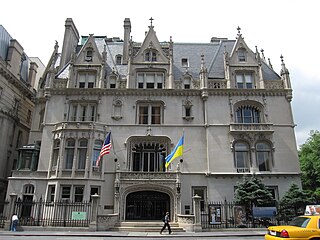
The Harry F. Sinclair House, also called the Isaac D. Fletcher House, is a mansion at the southeastern corner of East 79th Street and Fifth Avenue, Manhattan, New York City. The Sinclair House was built in the last three years of the 19th century. Over the first half of the 20th century, the house was successively the residence of magnates Isaac D. Fletcher and Harry F. Sinclair, and then the descendants of Peter Stuyvesant, the last Director of New Netherland. In 1955, it became the home of the Ukrainian American Institute, which began restoring the Sinclair House. The house was added to the National Register of Historic Places and was named a National Historic Landmark in 1978.

The John Philip Sousa House, also known historically as Wildbank, is a historic house at 12 Hicks Lane, overlooking Manhasset Bay, in Sands Point, New York. Built in 1907, it was the home of composer and bandleader John Philip Sousa (1854-1932) from 1912 until his death. It was declared a National Historic Landmark in 1966. It is still a private residence and is not open to the public.

Rose Hill Mansion is a historic house museum on New York State Route 96A in Fayette, New York. Built in 1837 on a site overlooking Seneca Lake, it is one of the nation's finest examples of monumental residential Greek Revival architecture. The property was declared a National Historic Landmark in 1986. It is now owned and operated by the Geneva Historical Society, and is open for tours in the warmer months.

The James Watson House, at 7 State Street between Pearl and Water Streets in the Financial District of Manhattan, New York City, was built in 1793 and extended in 1806, and is now the rectory of the Shrine of St. Elizabeth Ann Bayley Seton. It is located near the southern tip of Manhattan Island, across from Battery Park.
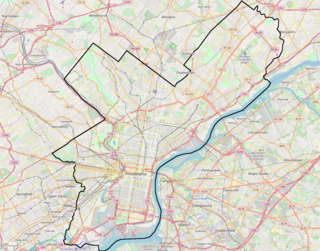
The Thomas Sully Residence is a historic rowhouse at 530 Spruce Street in Philadelphia, Pennsylvania, USA. It was briefly (1828-29) a home of painter Thomas Sully (1783-1872), who lived in Philadelphia for the last 64 years of his life. It was declared a National Historic Landmark in 1965. It is a private residence, and is not open to the public.

Mount Clare, also known as Mount Clare Mansion and generally known today as the Mount Clare Museum House, is the oldest Colonial-era structure in the City of Baltimore, Maryland, U.S.A. The Georgian style of architecture plantation house exhibits a somewhat altered five-part plan. It was built on a Carroll family plantation beginning in 1763 by barrister Charles Carroll the Barrister, (1723–1783), a descendant of the last Gaelic Lords of Éile in Ireland and a distant relative of the much better-known Charles Carroll of Carrollton, (1737–1832), longest living signer of the Declaration of Independence and the richest man in America in his later years, also the layer of the First Stone of the new Baltimore and Ohio Railroad, just a short distance away in 1828.

Brookside Museum, sometimes known as the Aldridge House, is located on the western edge of downtown Ballston Spa, New York, United States. It is a wooden house built in 1792, one of the oldest in the village, but modified since then.

The Winslow Ames House is a prefabricated modular International Style house in New London, Connecticut, United States. It was designed by Robert W. McLaughlin, Jr. and was built in 1933. Winslow Ames, a professor of art history at Connecticut College and the art director of the Lyman Allyn Museum, had the home built after attending the Century of Progress Exposition in Chicago. Constructed for $7,500, the prefabricated house is one of two surviving Motohomes produced by McLaughlin's company American Houses Inc. The modular house, comprising three rectangles and a flat roof, was constructed on a concrete slab with a welded steel framework. It was made with asbestos panels and features a core component that provides the heating and plumbing functions for the house. The other two modules feature two bedrooms and a one-car garage.
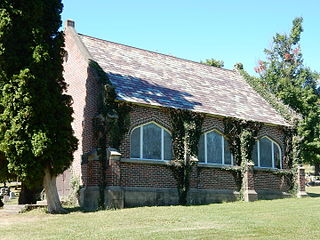
Lake View Cemetery is a historic cemetery located at Penn Yan in Yates County, New York. It is a 50-acre (20 ha) cemetery property that includes wooded and open acres included in the cemetery's historic landscape plan and developed in two phases between about 1855 and 1906. The property includes the Abraham Wagener Memorial Chapel, a two-story brick Gothic Revival structure built in 1923–1924. It was listed on the National Register of Historic Places in 1996.

The Benjamin N. Duke House, also called the Duke–Semans Mansion and the Benjamin N. and Sarah Duke House, is a landmarked mansion located at 1009 Fifth Avenue at East 82nd Street in the Upper East Side of Manhattan, New York City. It was built in 1899-1901 and was designed by the firm of Welch, Smith & Provot in the Beaux-Arts style.

The John N. Ingersoll House is a single-family home located at 570 West Corunna Avenue in Corunna, Michigan. It was listed on the National Register of Historic Places in 1980.
